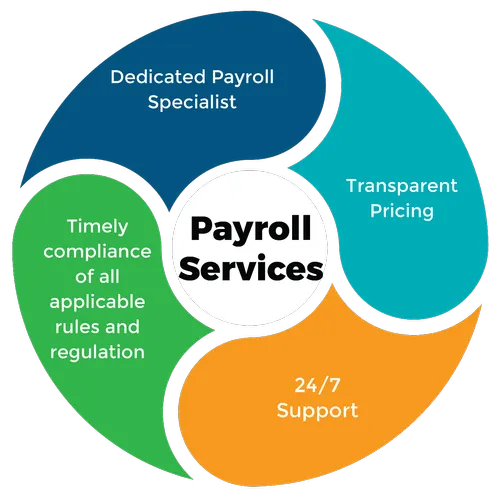the Methods involved?
Every firm, regardless of size or sector, has one thing in common: they all have to conduct payroll for their workers. Payroll processing, however, might vary from one company to the next. As a result, understanding how to handle payroll and determining the best strategy to develop a simpler workflow for your firm is critical.
Initiating Payroll Processing? What are the Methods involved?
Creating a new payroll system involves more than simply handing out paychecks. As one of the leading payroll processing companies in Delhi, we at EasySource can vouch for this. Payroll processing is integral to running a business, so it’s important to know any applicable local, state, or federal regulations.
First Stage: Payroll Preparation (Activities Before Payroll Processing)
The first stage in payroll processing is defining payroll policy, which entails establishing the guidelines to be followed throughout the procedure. These guidelines are subject to management’s approval.
There are many different types of policies, but some common ones include those about attendance, compensation, time off, and benefits. Organizations with well-defined payroll policies and processes can better pay their workers on time and properly.
Collecting Data
To begin processing payroll, you must first collect the required tax information from your workers. Employees must provide their employer with a valid identity as part of this procedure before they may begin their new position.
These documents are required by the Internal Revenue Service and your state’s revenue department because they provide information about your tax withholding obligations. Even if your worker qualifies as an independent contractor, he or she still has to complete certain necessary documents.
Evaluating Inputs
After collecting data, it’s imperative to double-check its accuracy before moving on with payroll. Verify that there are no inactive workers on the list and that all current ones are included. See whether the information is in line with business standards. Insist on a proper data structure being used.
Second Stage: Main Payroll Process
Establish a System for Record Management
If you manage a company, you’ll need to preserve various records relating to your personnel. For accurate payroll deductions, you’ll need proof of the benefits and retirement plans they’ve chosen. Employment agreements, tax documents, employee handbooks, and training records must also be signed and filed.
Using an employee record management procedure simplifies the administration of all these variables. All information about employees’ salaries, deductions, and other financial matters must be verified against official documents.
Compensation figures calculation
When this phase is reached, the pre-payroll tasks have been completed, and real work is being done to obtain the workers’ net pay. Payroll data like attendance and leave information will need to perform shift-wise calculations, deductions, tax, incentives, costs, etc., as part of the pre-payroll process.
After double-checking the information, it may be added to the payroll system. You will get your “net pay” after all mandatory taxes and deductions have been taken out. The procedure should be double-checked to remove any room for mistakes.
Time and Attendance Recording
Processing payroll and keeping track of time worked go hand in hand. Paying workers is based on time-related factors like the number of hours worked. It is critical to have an efficient time and attendance system in place to guarantee that employees’ time is being recorded correctly. Lunches, breaks and accruals should all be recorded to avoid overpaying or underpaying staff.
It’s important to provide many time-recording methods to workers for an efficient payroll process. Clocking in across locations, time zones, and projects are possible with several options such as paper time cards, electronic timesheets, and mobile applications. Workers may be held more responsible with this level of detailed attendance monitoring.
Third Stage: Post Payroll Activities
Accountancy for Payroll
Each business must keep precise financial records, and salaries are a major expense item. Salary information must be recorded into an ERP or accounting system during payroll.
Don’t forget to factor in federal non-banking holidays if you conduct payroll manually. There will be a holdup in direct deposits because of the holidays. Maintain a steady supply of paper, ink, and other essentials for check printing.
Working with a payroll service doesn’t mean you won’t be affected by the service’s holidays. Regardless of the circumstances, it is crucial to have a strategy to ensure that workers will be paid on time.
Statutory Compliance
The payroll administrator must strictly follow all legal requirements throughout the payroll procedure. Payroll processing includes withholding mandatory fees and taxes such as PF, ESI, and TDS.
These are deductions from an employee’s paycheck before federal, state, and local taxes are applied. Health insurance paid for by the company, employee retirement payments, and employer retirement contributions are all good examples.
These amounts may be deducted from your paycheck before paying federal income tax. To comply with legal requirements, businesses must withdraw taxes from their employees’ salaries and remit the funds to the relevant authorities.
Payout
After these measures have been taken, salary payments may be made by check, cash, or electronic transfer. Payroll accounts help for smooth money transfers between employers and workers. The employer must provide the branch with payroll bank account statements that include the employee’s ID, account number, and other pertinent information to have salary deposits made to an employee’s account.
Reporting
The next stage is reporting; for this, you’ll need to compile precise data, such as the total amount spent on employees across all departments and locations. These reports are sent to the accounting group or management for additional review.
When you’ve finished processing payroll for the month, the finance and upper management team may request reports detailing employee costs by department, location, etc. Your payroll officer role will require you to investigate, gather information, and distribute reports.
Looking for the Top payroll processing companies in Delhi?
We, EasySource India, are one of the Best payroll processing companies in Delhi. To get started with payroll, our consultants can help you reach out to their extensive network of contacts. We deliver seamless services to our clients, from recruitment to training, onboarding, and offboarding. We have spent time and effort building a strong relationship with client partners. Get in touch with us, and we’ll be pleased to provide you with a consultation.




